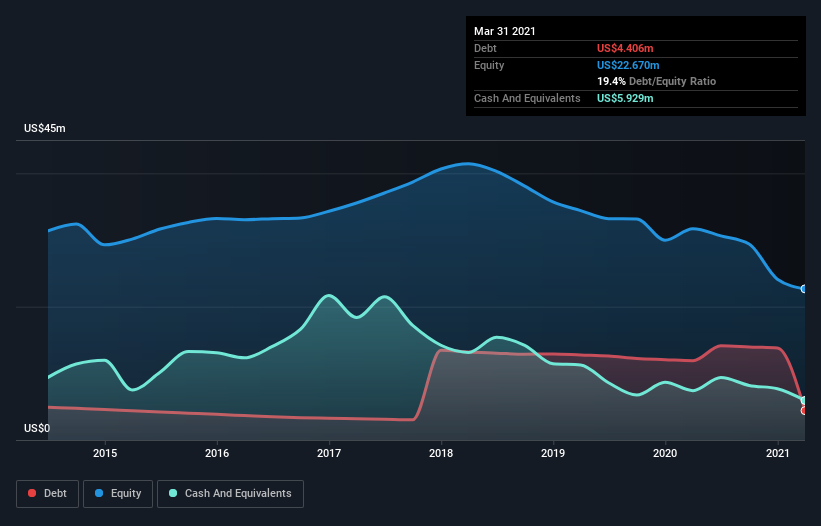Is CVD Equipment (NASDAQ:CVV) Weighed On By Its Debt Load?
David Iben put it well when he said, 'Volatility is not a risk we care about. What we care about is avoiding the permanent loss of capital.' It's only natural to consider a company's balance sheet when you examine how risky it is, since debt is often involved when a business collapses. Importantly, CVD Equipment Corporation (NASDAQ:CVV) does carry debt. But the real question is whether this debt is making the company risky.
When Is Debt A Problem?
Generally speaking, debt only becomes a real problem when a company can't easily pay it off, either by raising capital or with its own cash flow. If things get really bad, the lenders can take control of the business. However, a more frequent (but still costly) occurrence is where a company must issue shares at bargain-basement prices, permanently diluting shareholders, just to shore up its balance sheet. Of course, the upside of debt is that it often represents cheap capital, especially when it replaces dilution in a company with the ability to reinvest at high rates of return. The first thing to do when considering how much debt a business uses is to look at its cash and debt together.
See our latest analysis for CVD Equipment
What Is CVD Equipment's Net Debt?
You can click the graphic below for the historical numbers, but it shows that CVD Equipment had US$4.41m of debt in March 2021, down from US$11.9m, one year before. But on the other hand it also has US$5.93m in cash, leading to a US$1.52m net cash position.
How Strong Is CVD Equipment's Balance Sheet?
We can see from the most recent balance sheet that CVD Equipment had liabilities of US$14.1m falling due within a year, and liabilities of US$2.42m due beyond that. On the other hand, it had cash of US$5.93m and US$2.56m worth of receivables due within a year. So its liabilities outweigh the sum of its cash and (near-term) receivables by US$8.04m.
This deficit isn't so bad because CVD Equipment is worth US$27.7m, and thus could probably raise enough capital to shore up its balance sheet, if the need arose. But we definitely want to keep our eyes open to indications that its debt is bringing too much risk. While it does have liabilities worth noting, CVD Equipment also has more cash than debt, so we're pretty confident it can manage its debt safely. The balance sheet is clearly the area to focus on when you are analysing debt. But you can't view debt in total isolation; since CVD Equipment will need earnings to service that debt. So when considering debt, it's definitely worth looking at the earnings trend. Click here for an interactive snapshot.
Over 12 months, CVD Equipment made a loss at the EBIT level, and saw its revenue drop to US$14m, which is a fall of 36%. That makes us nervous, to say the least.
So How Risky Is CVD Equipment?
We have no doubt that loss making companies are, in general, riskier than profitable ones. And in the last year CVD Equipment had an earnings before interest and tax (EBIT) loss, truth be told. Indeed, in that time it burnt through US$3.2m of cash and made a loss of US$9.2m. However, it has net cash of US$1.52m, so it has a bit of time before it will need more capital. Summing up, we're a little skeptical of this one, as it seems fairly risky in the absence of free cashflow. When analysing debt levels, the balance sheet is the obvious place to start. However, not all investment risk resides within the balance sheet - far from it. These risks can be hard to spot. Every company has them, and we've spotted 3 warning signs for CVD Equipment (of which 1 is concerning!) you should know about.
At the end of the day, it's often better to focus on companies that are free from net debt. You can access our special list of such companies (all with a track record of profit growth). It's free.
This article by Simply Wall St is general in nature. It does not constitute a recommendation to buy or sell any stock, and does not take account of your objectives, or your financial situation. We aim to bring you long-term focused analysis driven by fundamental data. Note that our analysis may not factor in the latest price-sensitive company announcements or qualitative material. Simply Wall St has no position in any stocks mentioned.
Have feedback on this article? Concerned about the content? Get in touch with us directly. Alternatively, email editorial-team (at) simplywallst.com.

